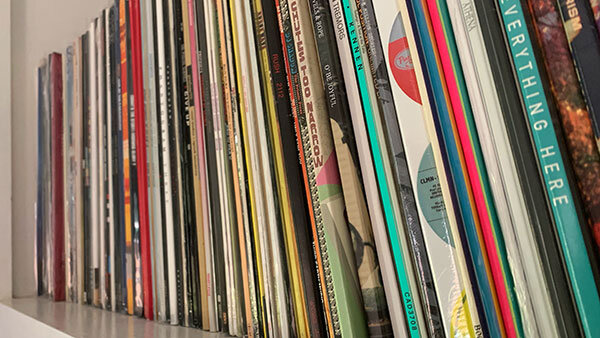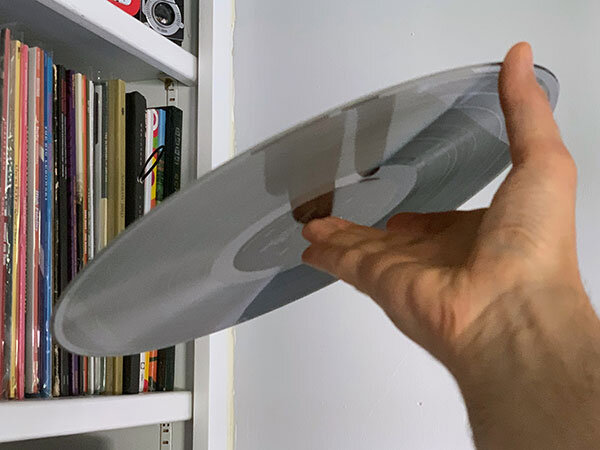Records Collect Dust: What are We Gonna Do About It?
Most of us buy vinyl records to listen to them. A novel idea, right? Smudges, blemishes, and dust are a part of the vinyl listening experience. The combination of debris and static electricity can create a cyclical attraction which can lead to long term excessive wear on our records... and our equipment (specifically the stylus). Scary stuff!
Since we buy our vinyl records to listen to and enjoy, we’re going to cover the details that help avoid the dirt, clean the dust, and keep our records healthy for the long haul. Because loving something and taking care of it go hand and hand. Usually.
If you are a collector who likes to play and display your records, not just store them away on the shelf, join the club and let’s dive in.
Before the needle hits the record
For the majority of their life, records are stored on the shelf (or so we hope). If not, let’s get your record storage sorted out.
When we’re not listening to records for a prolonged period and they’re stored away on a shelf or out of sight, dust will still find a way in. And to take it one step back, we need to realize that records come pre-sealed in their sleeves with dust and debris welcoming us straight from the factory. It’s commonplace.
Add to this, our fresh new records that glisten on first light, often come positively charged with static electricity. Static acts as a magnet for pesky airborne particles. All this goes to say, dust is inevitable. Knowing the best way to clean our records is just a part of being a responsible record mom and dad.
Where does the dust go?
Let’s allow our nerdom to run wild for a moment and briefly look at the mechanics of how records work. Music on vinyl is extracted as the stylus on our turn-table dances through the grooves (dance is a great technical term, don’t even question it). This creates friction which in turn creates heat. The process is strenuous by nature.
Now, add in some dust in the mix and instead of playing the grooves, the stylus plays the debris on the record as well. Which is just as awful as it sounds. We can hear a range of anything from small clicks, pops, and slight distortions, to long term effects of skipping and interoperability.
Since most of us don’t have dedicated vacuum-sealed listening rooms (yet), our records, no matter what we do, are going to collect dust in the grooves. It’s normal. It is what it is.
So how do we keep our vinyl records as clean as possible (while enjoying our perfectly exquisite taste in music) far into the future? With a few good habits, we can ensure our vinyl stays in tip-top shape.
Vinyl Cleaning Methods — Tips and Comparisons
Dry Method – The Number 1 Thing We Should Do Before Every Spin.
The Groovewasher brush with G2 cleaning solution (back), and the RecordHappy brush kit with included stylus brush (front).
A vinyl record brush (or a dust cloth) is a must. If you’re going to start collecting records, make this the first accessory on your list. Dust brushes remove the majority of top-level dust and particles that might have made their way onto the record between the factory and the packaging, or the used record bins and our listening station.
Anti-static brushes are made with synthetic fibers that aim to dissipate static, so when we finish dusting off the record, the dust cycle doesn’t immediately begin again. There are so many record cleaning brushes available, but for about $15 on Amazon, you can get started avoiding the snap, crackle, and pop of your dirty album, and protect your collection so it will outlive you. Take a gander at a few of our recommended picks.
With your trusty record brush in hand. place a record on the turntable, turn it on, hold your brush at a 90-degree angle and lightly touch the surface of the record so the brush moves through the grooves as the record spins. Because the grooves act as a dust holding cell, we are trying to delicately wipe out debris while it spins.
Remember to be delicate when cleaning records – we don’t want to push dust further into the grooves. And then remember to clean all the dust particles off your brush between each clean (some brushes even have dust-removing compartments built right into the container of the brush). After a few rotations, you’re ready to drop the stylus on the record and enjoy the listen.
Wet Method – Removing Smudges and Deeper Grit
When our dust is cleared, sometimes we still need to take a closer look at removing fingerprints or smudges from a record. A wet method of cleaning is especially necessary if you have a particularly old record that needs some TLC (shout out to our ladies – don’t go chasing waterfalls).
For wet method record cleaning, look for a cleaning solution and record-cleaning cloth to add to your arsenal. There are many available and there is no need to break the bank here. Whatever you do, try not to use soap, water, alcohol or other DIY solutions. It’s not worth the risk of harming your records or your stylus. Causing damage beyond repair is just too easy.
When it comes to cleaning vinyl records, it is all about the circular motion, and for this wet method, just spray your cleaning solution onto your record-cleaning cloth and begin lightly wiping your vinyl in a circular movement going in the direction of the grooves. Easy peasy.
When all else fails, for the most stubborn of record skipping or for old dusty records that need the most love and revival, consider investing in a record cleaning machine for the deepest level of wet cleaning. SpinClean is the renowned industry leader, which cleans both sides of your record simultaneously and with ease. They will admit that the secret to their cleaning success is in their cleaning solution which they also conveniently sell separately but it’s hard to deny the power and efficiency of a record cleaning machine like SpinClean.
Other Ways to Keep your Vinyl Looking Fine
Hold vinyl records by the edge and/or the label area, and try not to touch those grooves.
Record Etiquette 101 tells us to always handle our vinyl by the edges. Even if you think your fingers are clean, they are not. They are oily and they can quickly create smudges before you get records on the platter or back in the sleeve.
Don’t forget the all important stylus. A clean stylus is just as important as a clean record – why spend so much time keeping vinyl clean if we are just going to play it again with a dirty needle? Some record brushes come with stylus brushes built right in, but even if you opt for one that doesn’t, there is no need to break the bank on a stylus brush. They’re inexpensive and help get rid of any dust that might have built up naturally from playing records. Pick one up and keep it for the life of your collection.
Record player dust covers are one more avenue to avoiding extra dust from affecting our equipment. Some record players come with dust covers built in. Some are sold separately. And many hi-fi units don’t have dust covers at all. It can be argued that you will achieve better sound quality from vinyl without a dust cover, which can create additional friction and vibration that transmit to the audio during play. That said, it will take a well trained ear, combined with hi-fi stereo and speaker equipment to audibly notice the difference. For the majority of listeners, our dust covers are best suited for keeping more dust away.
Vinyl: The Evergreen Music Medium
When taken care of properly, records can last longer than humans. And while so much of our music is now digital, there is something special about physically passing down our history in music. Sure, our grandchildren may make fun of us because we thought (insert your favorite album here) was the best album of our generation, but isn’t that a piece of our history we’d like to be a part of?
Vinyl is so strong, in more ways than one. All we have to do is keep our records clean and properly stored. And that’s a small price to pay for those of us that actually like to play.
Play on, y’all.
Looking to Play AND Display? Record Props attract no more dust than usual, like playing a record without a dust cover. Take it from listeners with decades of experience. We’ve got your continuous rotation in check.






